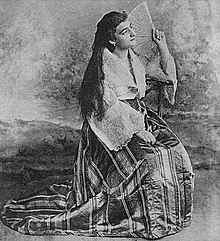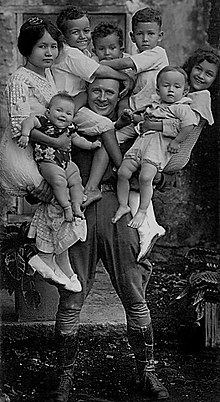
Demography of the Philippines records the human population, including its population density, ethnicity, education level, health, economic status, religious affiliations, and other aspects. The Philippines annualized population growth rate between the years 2015–2020 was 1.63%. According to the 2020 census, the population of the Philippines is 109,035,343. The first census in the Philippines was held in the year 1591 which counted 667,612 persons.

Creole people are ethnic groups which originated during the colonial era from racial mixing mainly involving West Africans as well as some other people born in colonies, such as African, French, Spanish, and Indigenous American peoples; this process is known as creolization. Creole peoples vary widely in ethnic background and mixture and many have since developed distinct ethnic identities. The development of creole languages is sometimes mistakenly attributed to the emergence of creole ethnic identities; however, the two developments occur independently.

Mestizo is a racial classification used to refer to a person of a combined European and Indigenous American ancestry. The term was used as an ethnic/racial category for mixed-race castas that evolved during the Spanish Empire. Although, broadly speaking, mestizo means someone of mixed European/indigenous heritage, the term did not have a fixed meaning in the colonial period. It was a formal label for individuals in official documentation, such as censuses, parish registers, Inquisition trials, and other matters. Priests and royal officials might label individuals as mestizos, but the term was also used for self-identification.
A Eurasian is a person of mixed Asian and European ancestry.
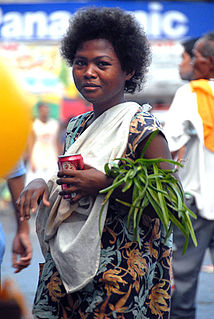
The Negrito are several diverse ethnic groups who inhabit isolated parts of Southeast Asia and the Andaman Islands. Their current populations include: the Andamanese peoples of the Andaman Islands, the Semang peoples of Peninsular Malaysia, the Maniq people of Southern Thailand, as well as the Aeta of Luzon Island, Ati and Tumandok of Panay Island, Agta of Sierra Madre and Mamanwa of Mindanao Island and about 30 other officially recognized ethnic groups in the Philippines.
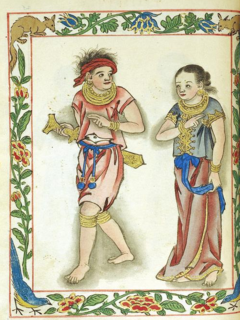
Visayans or Visayan people, are a Philippine ethnolinguistic group native to the whole Visayas, the southernmost islands of Luzon and many parts of Mindanao. They are the largest ethnic group in the geographical division of the country when taken as a single group, numbering some 33.5 million. The Visayas broadly share a maritime culture with strong Roman Catholic traditions merged with cultural elements through centuries of interaction and inter-migrations mainly across the seas of Visayas, Sibuyan, Camotes, Bohol and Sulu and in some secluded areas merged with ancient animistic-polytheistic influences. Most Visayans are speakers of one or more Bisayan languages, the most widely spoken being Cebuano, followed by Hiligaynon (Ilonggo) and Waray-Waray.

The Spanish influence on Filipino culture has been profound, having originated from the Spanish East Indies. A variety of aspects of the customs and traditions in the Philippines today can be traced back to this influence.
In the context of the Spanish colonial empire, a peninsular was a Spaniard born in Spain residing in the New World, Spanish East Indies, or Spanish Guinea. Nowadays, the word peninsulares makes reference to Peninsular Spain and in contrast to the "islanders" (isleños), from the Balearic or Canary Islands or the territories of Ceuta and Melilla.

Chinese Filipinos or Filipino Chinese, are Filipino citizens of Chinese descent, mostly of Hoklo (Hokkien) ancestry, where the majority are born and raised in the Philippines. Chinese Filipinos are one of the largest overseas Chinese communities in Southeast Asia. In 2013, there were approximately 1.35 million Filipinos with Chinese ancestry. In addition, Sangleys—Filipinos with at least some Chinese ancestry—comprise a substantial proportion of the Philippine population, although the actual figures are not known.

The Aeta, Agta, or Dumagat, are collective terms for several Filipino indigenous peoples who live in various parts of the island of Luzon in the Philippines. They are considered to be part of the Negrito ethnic groups and share common physical characteristics of dark skin tones, short statures, curly to Afro-textured hair, and a higher frequency of naturally lighter hair colour (blondism) relative to the general population. They are thought to be among the earliest inhabitants of the Philippines, preceding the Austronesian migrations. Regardless, modern Aeta populations have significant Austronesian admixture and speak Austronesian languages.

Torna atrás or Tornatrás is a term once used in 18th century Casta Paintings to portray a mixed-race person (mestizo) who showed phenotypic characteristics of only one of the "original races", that is, white, black, Amerindian, or Asian. The term was also used to describe an individual whose parentage was half white and half "albino".
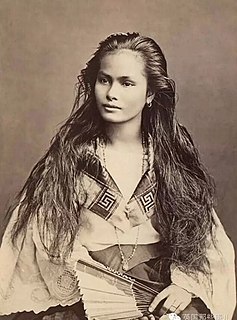
Sangley is an archaic term used in the Philippines to describe a person of mixed Chinese and Filipino ancestry.

Filipinos are the people who are native to or citizens of the country of the Philippines. Filipinos come from various Austronesian ethnolinguistic groups. Currently, there are more than 185 ethnolinguistic groups in the Philippines; each with its own language, identity, culture and history.

The Philippines is inhabited by more than 175 ethnolinguistic nations, the majority of whose languages are Austronesian in origin. Many of these nations converted to Christianity, particularly the lowland-coastal nations, and adopted foreign elements of culture. Ethnolinguistic nations include the Ilocano, Ivatan, Pangasinan, Kapampangan, Tagalog, Bicolano, Visayans, Zamboangueño, Subanon, and more.

The principalía or noble class was the ruling and usually educated upper class in the pueblos of the Spanish Philippines, comprising the Gobernadorcillo, who was later referred to as Capitan Municipal, El Teniente de Justicia, and the Cabezas de Barangay who governed the districts, former Gobernadorcillos or Municipal Captains, and Municipal lieutenants in good standing during their term of office.
Mexican settlement in the Philippines comprises a multilingual Filipino ethnic group composed of Philippine citizens with Mexican ancestry. The immigration of Mexicans to the Philippines dates back to the Spanish period.

Spanish Filipinos are an ethnic group who trace their ancestry to early Spanish settlers and more recent arrivals or via Mexico who settled in the Philippines during the 16th to 20th century.
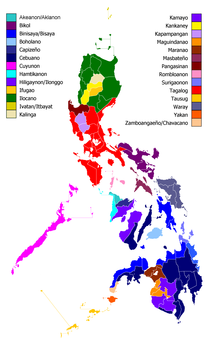
Racism in the Philippines is multifarious and emerged in various portions of the history of people, institutions and territories coinciding to that of the present-day Philippines.
Latin American Asians are Asian people of full or partial Latin American descent.

Tipos del País, literally meaning Types of the Country, is a style of watercolor painting that shows the different types of inhabitants in the Philippines in their different native costumes that show their social status and occupation during colonial times.



